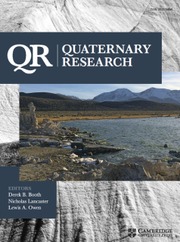In the original publication of Biton et al. (Reference Biton, Bailon, Goren-Inbar, Sharon and Rabinovich2019), a mistake appeared in the abstract of the article. The sentence that reads “Most of the amphibian and squamate taxa recovered are aquatic species related to the natural biota of the Hula Valley, alongside some terrestrial species” should instead read as follows: “Most of the amphibian and squamate remains identified to species/genus are related to the aquatic natural biota of the Hula Valley, alongside some terrestrial species remains.”
Additionally, the “aquatic” taxa referred to in the text should not have included Hyla. Natrix sp. should have been referred to as a semi-aquatic snake: the sentence “This is particularly relevant for the aquatic taxa: Pelophylax cf. bedriagae, Latonia nigriventer, Hyla sp., and Natrix sp.” should be corrected to “This is particularly relevant for the aquatic anuran Pelophylax cf. bedriagae and Latonia nigriventer, and the semi-aquatic snake Natrix sp.” Furthermore, the sentence: “The most abundant species in all archaeological assemblages under study are the aquatic species: the Hula painted frog (Latonia nigriventer), the Levant green frog (Pelophylax cf. bedriagae), a tree frog (Hyla sp.), and a water snake (Natrix sp.). Their ecological requirements indicate the presence of permanent bodies of water” is incorrect. The correct sentence is “The most abundant species in the majority of the archaeological assemblages under study are aquatic anurans, the Levant green frog (Pelophylax cf. bedriagae) and the Hula painted frog (Latonia nigriventer), and a semi-aquatic water snake (Natrix sp). The aquatic frogs’ ecological requirements indicate the presence of permanent bodies of water.”
The anurans MNE was calculated mainly based on specific segments of an element. The distal humerus and posterior ilium were the areas mostly used for the calculation.
The last sentence on page 354 in the description of Dolichophis jugularis should be modified and not include “…with a small ventral notch.” On the same page, the description of Malpolon vertebrae should not include the length of the prezygapophiseal process, since they were always found broken; moreover the haemal keel is typically prominent, not prominent and sharp.
Psammophis cf. schokari taxon is possibly a wrong identification and therefore not present at NMO. Four vertebrae were assigned to this taxon (Fig. 6E, Table 1, 2). All should now be identified as snake indet. This taxon is therefore deleted from both Table 1 and Table 2. All references to it in the text should be disregarded, mainly p. 359: “The snake Psammophis schokari, recovered at NMO, has not been currently observed in the Hula Valley (Table 2), although its geographic distribution is reported to be throughout Israel (Werner, 2016).” The sentence in the abstract stating “Twelve amphibian and squamate taxa were recovered at each site” is now incorrect; only eleven taxa were now recovered at NMO. The justification for the change of the vertebrae to an unidentified snake taxon is that the haemal keel is wider and more prominent than Psammophis schokari; the centrum is slightly less elongated than typical Psammophis vertebrae, and the neural arch is less vaulted.
The name of an author cited multiple times in the article is misspelled. The correct citation is Lloveras et al. 2014, 2017.
The authors apologize for the errors.
Corrected Table 2




